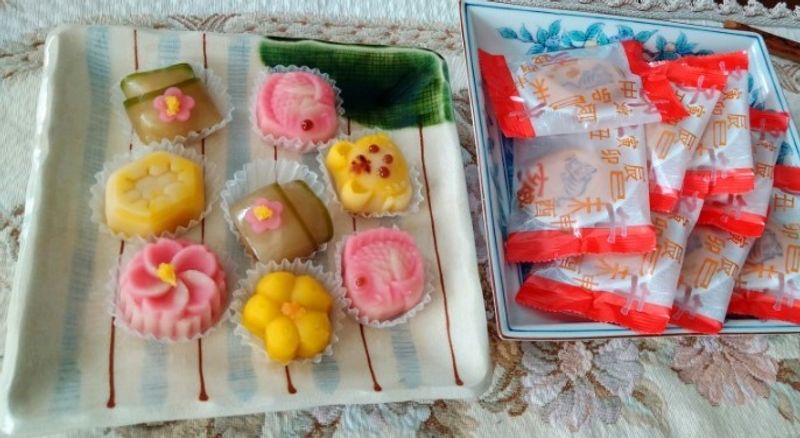Jan 5, 2022
New Year's Wagashi and Matcha
One of the treats my family has in store every new years is the post-shrine trip to my in-laws where we are treated to a lovely set of sweets and freshly mixed, proper, tea-ceremony grade matcha courtesy of my mother-in-law.

I cannot stress how wonderful it is to come into a nice warm home after a long walk through the slush and the crowds to find a warm, foamy green beverage waiting for me.
Wagashi is the term for any traditional sweets that are usually served with green tea and unfortunately I haven't been able to more specifically label the delicious things I encounter every year. The treats come in a variety of shapes and the least interesting but consistently delicious of which is the sweet bun with the symbol for the new year's zodiac animal printed on the front. Inside this delicious confection is a sweetened mound with the texture of sweet potato. I can't tell exactly what is inside of them but it isn't the normal reddish brown anko bean paste that is so commonly found inside of traditional Japanese sweets.

The other wagashi came in a larger variety of shapes, each with its own new years twist on the normal flowers and leaves and the like. I chose a pink fish and was excited to find that there was no anko (red bean paste) inside.

I don't hate anko but it isn't something I can say I enjoy either. This pinkness? A blessing!
The pink fish is meant to be tai, or red seabream, which is more commonly seen to the Japanese snack enthusiast as in taiyaki, the fried fish-shaped bun with anko (or better yet, any other) filling. Why is this in the New Years mix? Because the name for the fish (鯛) is closely related to the Japanese word for celebration (omedetai) and the fish itself is usually reserved for special occasions, as another great blogger has mentioned before.
The little pink blossoms on the green striped bits are meant to be ume or plum blossoms, symbols of the coming spring and apparently are said to ward off evil.
The yellow one with the honeycomb-like pattern is actually supposed to be a tortoise shell, symbolizing longevity and good luck. Turtles are really common symbols around New Years in Japan.
The pink flower is sakura or cherry blossom, made obvious by the petal shape and color. The symbol of Japan and the coming spring reminds us also to enjoy the good times while they exist as the blossoms themselves never stay in bloom for long.
Being that this picture was taken in early 2022, it should be obvious that the little tiger represents the coming year in the shape of its animal zodiac.
Unfortunately, I wasn't able to identify the yellow flower on its own as it doesn't really appear to be a chrysanthemum and doesn't make sense to be a plum blossom if the tiny pink one is a plum blossom.
I did find one extra Easter egg of a detail while writing this post though. The individual plates that the snacks are served on are a strange shape, aren't they? The pictures fail to capture a short handle that sticks off of the quadrilateral shape of the main plate with its odd little shuttle-cock shapes in the background. It turns out these plates are made specifically for new years and replicate the shape of the wooden rackets that were traditionally used for a net-less form of badminton that had been a staple of New Years entertainment in Japan many years ago. Both the rackets and the shuttlecocks are still symbols of the season.
Whatever your new years treats look like, let's hope the year ahead is a sweet one.



0 Comments